Stephen King is a universe, and I don’t just mean that he contains multitudes or that his bibliography is really big. He is a universe in the sense that he operates under his own physical laws. Two of the underlying forces that underpin his existence are described in his introduction to Nightmares and Dreamscapes, his third collection of short stories.
One force is his desire to sprawl, his tendency towards what he calls generosity. “The leap of faith necessary to make the short stories happen,” he writes, “has gotten particularly tough in the last few years; these days it seems that everything wants to be a novel, and every novel wants to be approximately four thousand pages long.” The opposing force is his desire to please the reader by presenting only his best material when it would be so easy to coast or to repeat himself. “What I’ve tried hardest to do is to steer clear of the old chestnuts, the trunk stories, and the bottom-of-the-drawer stuff,” he writes two pages later. These two forces pull him in opposite directions, and the result is, as he describes it, “an uneven Aladdin’s cave of a book.” With the emphasis on “uneven.”
After more than 20 years, it takes three books to round up all the Stephen King short fiction that he feels is fit to print. But unlike his first collection, Night Shift (1978), which leaned towards stories of individuals going mad or undergoing transformations (“Grey Matter”, “I Am the Doorway”, “Strawberry Spring”, “The Boogeyman”, “The Man Who Loved Flowers”), or Skeleton Crew (1985) which leaned towards stories about monsters (“The Mist”, “The Monkey”, “The Raft”, “Mrs. Todd’s Shortcut”, “Gramma”), Nightmares and Dreamscapes seems to have no unifying principle other than clearing out King’s files. The stories tend toward crime (“Dolan’s Cadillac”, “My Pretty Pony”, “The Fifth Quarter”, “The Doctor’s Case”) but they range from Lovecraftian pastiche, to hardboiled homage, to non-fiction about baseball, to Romero zombie fiction. A better unifying theme might be “Stephen King trying to sound like other writers.”
“Dolan’s Cadillac” 1985, Castle Rock newsletter
Things kick off with a very long, very EC Comics story that pays tribute to Edgar Allan Poe’s “The Cask of Amontillado” (right down to a quoted line of dialogue). A meek school teacher becomes obsessed with revenge after his wife testifies against a big-time mobster and gets whacked for her trouble. His revenge plan unfolds over seven years and there’s a compelling “dirt-under-you-fingernails” veracity to the technical details. King hated this story after it was finished and filed it for years until he dragged it out when Lord John Press wanted an unpublished short story to release as a limited edition book. King likes to start his story collections with longer stories, but this is no “The Mist.”
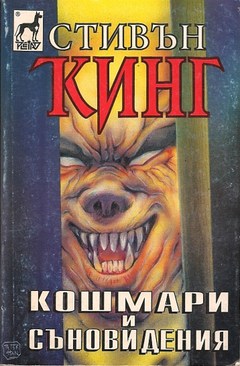 “The End of the Whole Mess” 1986, Omni
“The End of the Whole Mess” 1986, Omni
Written for Omni, the science fiction and science fact magazine backed by Penthouse publisher, Bob Guccione, this science fiction story is one of the three highlights of this collections. It winks at Flowers for Algernon but mostly showcases a writer firing on all cylinders technically, working with a novelist’s scope, and with a nice science twist at its heart. The only science fiction story in Skeleton Crew was “The Jaunt” which felt like Rod Serling on an off day, all exposition and with a sting which felt more formulaic than fresh. “The End of the Whole Mess” harkens back to King’s more successful “Night Surf”—his impressionistic sci-fi story from Night Shift.
“The End” tells the tale of two brothers, one of whom is so enormously intelligent that there’s something alien about him, and he winds up wiping out life on earth through the very best of intentions. In the notes to Nightmares and Dreamscapes, King describes his brother, Dave King, as being just this kind of person. Troubled over a technical detail in “Dolan’s Cadillac” he reached out to Dave (whom he describes as “a genuine polymath”) for help and received a videotape describing not only how to pull off the revenge in “Dolan’s Cadillac,” but also what equipment would be needed, and how to hotwire Highway Department vehicles. In an interview with the Houston Chronicle King talked about how Dave was the basis for the brother in “The End,” and that personal connection makes this story sing.
“Suffer the Little Children” 1972, Cavalier
An early story from King’s days hacking it out for the men’s magazines, this would have fit more comfortably in Night Shift, but his publisher probably didn’t want to have their suddenly successful author going out with a story in which a teacher murders a bunch of third graders.
“The Night Flier” 1988, Prime Evil anthology
Richard Dees, the tabloid reporter from The Dead Zone, shows back up to star in this story about a vampire airplane pilot. You can almost feel the parts of the story concerning Dees struggling to get bigger, yearning to grow to novella size at least, before the worried author chops it off with a bloody, rushed ending. It was later made into a movie that lasted less than a week in theaters and grossed $125,397.
“Popsy” 1987, Masques II anthology
This story about a guy who abducts the wrong little boy from a shopping mall is a clear sequel to “The Night Flier.” It gives readers a half-horror/half-crime short story that, like “The Night Flier,” comes to a sudden, bloody end. Unlike “The Night Flier” it feels like natural ending, and the story is a nice way to pass the time, save for the fact that the pedophile client who will be receiving the abducted child is a “big greasy Turk” who speaks with a cartoonishly strong accent. Stephen King may capture the fears of mainstream America, but sometimes those fears are darker than he realizes.
“It Grows on You” 1973, Marshroots
Originally written for one of the University of Maine’s literary mags, King extensively reworked this one before including it. Yet another story set in Castle Rock, it’s a Cthulhu mythos story that’s very well executed, but never really seems to go anywhere, mostly because the entire story is made up of memories and reminiscences.
“Chattery Teeth” 1992, Cemetery Dance
One of the weirdest stories of the bunch, a traveling salesman (who seems to be working the same route as Dolan, in fact you expect him to pass Dolan’s Cadillac) gets bailed out of a tight spot by a pair of wind-up novelty teeth. Tight and taut and a little silly, it’s an enjoyable time passer.
 “Dedication” 1988, Night Visions 5
“Dedication” 1988, Night Visions 5
Another of the three highlights of this collection, “Dedication” is not an easy story to like, but it comes from such a genuine place that it bears discussion. As King points out in his notes, this story has teeth. Martha Rosewell is a black housekeeper in a New York hotel who comes to work walking on air because her son has just published his first novel and dedicated it to her. She has a few drinks with a friend, and with liquor as the lubricant she spills the strange story about how her son was born. It’s a story that involves Martha, under a brujeria spell, gobbling up the cold semen from the sheets of a white, racist author who stayed in the hotel. The hardworking woman whose child becomes a successful writer through the downright insane sacrifices she makes is a character who crops up in King’s work many times, most notably here and in Dolores Claiborne.
It’s a clear tribute to his mother who put King and his brothers through school while working a variety of jobs, including at stint at an industrial laundry, and King writes these characters with a lot of love and invests them with a lot of nobility and intelligence, but what’s most striking is the amount of self-effacement involved. While King frequently praises the sacrifices made by his mother and his wife, he rarely gives himself any credit at all. The authors in King’s books are selfish, weak, addictive personalities (The Shining, “Secret Window, Secret Garden,” The Dark Half) and he never extends to them, and by extension himself, the generosity or understanding he does to his mother.
Another thing that raises this story above the pack is that Martha Rosewell is one of his first fully rounded African-American characters, so carefully written that while she is working class she only lapses into dialect when she’s drinking or imitating the speech of another character. While the semen eating (and there’s a lot of it) is kind of gross, this is what King does. He follows the story wherever it goes, no matter how rank things get.
“The Moving Finger” 1990, The Magazine of Fantasy and Science Fiction
A weird little doodle about a battle between a man and a long finger that comes out of the drain. Like “Chattery Teeth” it’s a fine way to pass the time, but not much more.
“Sneakers” 1988, Night Visions 5
Critics of Stephen King will find everything they hate about him wrapped up in one dubious package here: a disgusting ghost with a pencil through its eye, taking a poop, in a building full of rock and roll producers. Also, the bad guy turns out to be an evil homosexual. So let’s see: defecation, disgusting imagery, rock n’roll fannishness, and a minority turned into the evil other. Yep, it’s all there.
“You Know They Got a Hell of a Band” 1992, Shock Rock
Stephen King’s love of rock n’roll can get a bit cloying at times, especially in a book like Christine which is larded with licensed song lyrics. King’s obsession with the pop culture of his childhood can feel like listening to the Stand By Me soundtrack for the five millionth time, but what starts out like “Children of the Corn” meets a stoner discussion about who gets to go to rock and roll heaven, turns into a ferociously anti-nostalgia story that succeeds despite itself. This one would be dismissible as a time passer if it didn’t have such a powerful, poisonous sting in its tail that sees King interrogate his own tendencies towards nostalgia.
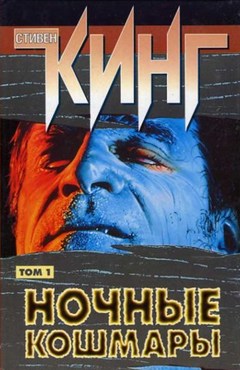 “Home Delivery” 1989, Book of the Dead
“Home Delivery” 1989, Book of the Dead
The third highlight from this collection, this story was written “to order” for an anthology set in the world of George Romero zombies. It’s the kind of story that demonstrates what’s so good about a Stephen King story. A pregnant woman living on a small island off the coast of Maine has to deal with Romero’s zombie apocalypse in a story that contains every possible element of Stephen King’s fiction: hardworking Maine lobstermen, a reference to his other works (in this case Little Tall Island from Dolores Claiborne), an abusive husband, a wise old timer who spits a lot, the death of a main character, science fiction elements, graphic descriptions of rot and violence presented in extreme close-up, and a sentimental view of small children, plus a lot of vomiting. And yet, the story works so well that it shakes the dust off King’s clichés and turns them into something vital and alive. Even folks who aren’t fans of Romero’s original living dead trilogy are going to find a story here that, no pun intended, really delivers.
“Rainy Season” 1989, Midnight Graffiti
Another time passer that’s no better or worse than the others in this book. Like “The Moving Finger” you get the impression King was seized by a particularly horrifying, surreal image and then built the story around it. The story is most notable for the fact that it ended the bout of severe writer’s block King suffered after finishing The Tommyknockers.
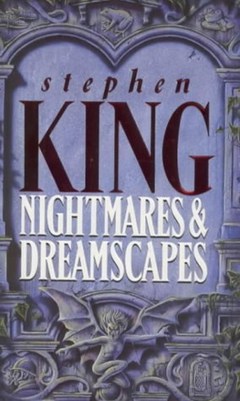 “My Pretty Pony” 1989, limited edition
“My Pretty Pony” 1989, limited edition
The story behind this story is more interesting than the story itself. “A bad piece of work born in an unhappy time of my life…” is how King describes it in the notes. Richard Bachman, King’s pseudonym, also had a pseudonym, George Stark, and in the early 80s he was working on a book by Bachman called Machine’s Way and a book by Stark called My Pretty Pony simultaneously. The projects fell apart, but Machine’s Way was repurposed almost a decade later into The Dark Half while the six remaining chapters of My Pretty Pony were buried in a file. King later unearthed it and found that one flashback felt like its own short story, and published it in a “overpriced and overdesigned” limited edition via the Whitney Museum. Oddly enough, the story is a through-the-looking-glass version of “The Wedding Gig” originally published in 1980 (and collected in Skeleton Crew), in which a gangland assassination takes place at a wedding. As for the story itself, it’s a labored explanation of the titular metaphor that’s almost unbearably in love with itself.
“Sorry, Right Number” 1987, Tales from the Darkside
Written for the Tales from the Darkside TV series and published as a screenplay, it’s a nice time passer about time passing.
“The Ten O’clock People” previously unpublished
A cross between this volume’s “Suffer the Little Children” and Night Shift’s “Quitters, Inc,” this story about a conspiracy of aliens to wipe out the human race is a fun monster yarn that would have felt at home in Skeleton Crew. Written in three days, it zings along and it’s one of the most satisfying time passers in this collection besides “You Know They’ve Got a Hell of a Band.”
“Crouch End” 1980, New Tales of the Cthulhu Mythos
King is usually at his weakest when he’s imitating H.P. Lovecraft, and this story feels like Stephen King imitating Ramsey Campbell imitating H.P. Lovecraft, making it a copy of a copy.
“The House on Maple Street” previously unpublished
With shades of Ray Bradbury, this tale of yet another teacher/author who abuses his children is a nice, satisfying dose of King, and it feels almost like a young adult story featuring an engaging cast of preteen siblings trying to navigate their way through a tough situation.
“The Fifth Quarter” 1972, Cavalier
It’s unclear why King republished this one, because it’s an imitation of one of Donald Westlake’s Parker novels, right down to the choice of language and the plot details.
“The Doctor’s Case” 1987, The New Adventures of Sherlock Holmes
This is Sherlock Holmes fan fiction that manages to be a passable Sherlock Holmes story with a strange, amoral twist. King does a fine job of imitating Doyle’s voice, but it’s not quite clear why he made the effort.
“Umney’s Last Case” previously unpublished
After two copies of other mystery authors, this story comes as a fun surprise. What starts as knock-off of hardboiled authors like Raymond Chandler and Ross Macdonald suddenly veers into Philip K. Dick territory and becomes a bizarrely original Stephen King story that actually pays off.
“Head Down” 1990, The New Yorker
A long non-fiction account of Owen King’s (Stephen’s son) little league season playing for Bangnor West as they go to the all-star championships. Depending on your taste for baseball it’s either an exercise in boredom or a straight-forward account of several little league baseball games. It’s also terrible non-fiction. King drops the normally chatty, intimate voice he uses in most of his non-fiction and tries to deliver a New Yorker piece with all the color drained out of it. Never one to fail when he puts his mind to it, he successfully drains all the color out of it.
“Brooklyn August” 1971, Io
A short baseball poem. King says it’s been widely anthologized and that’s not surprising. How many baseball poems by a best-selling author must there be out there?
“The Beggar and the Diamond” previously unpublished
A tiny little parable that’s almost sunk by an adverb at the end. Overuse of adverbs is something King warns against in his On Writing and has mentioned several times as something that he struggles against. You can see why.
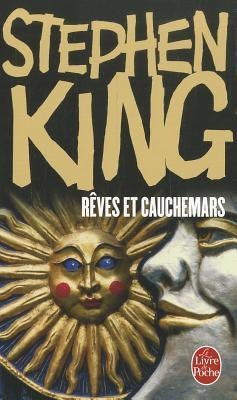 Nightmares and Dreamscapes hit the stands in September 1993, and heralded the start of a five year period during which King would only produce one book that fans consider among his best (The Green Mile). For most authors, a five year dry patch wouldn’t matter much, but for someone with such prolonged fertile periods in their past, it stands out. Nevertheless, Nightmares sold 1,328,927 copies in hardcover, and an additional 2.6 million in paperback. As King says in his introduction, “…some critics have been saying I could publish my laundry list and sell a million copies or so.” Or, in this case, he could clean out his drawers and sell almost four million copies. That’s not to say this collection is without merit, but it’s the weakest of his three short story anthologies.
Nightmares and Dreamscapes hit the stands in September 1993, and heralded the start of a five year period during which King would only produce one book that fans consider among his best (The Green Mile). For most authors, a five year dry patch wouldn’t matter much, but for someone with such prolonged fertile periods in their past, it stands out. Nevertheless, Nightmares sold 1,328,927 copies in hardcover, and an additional 2.6 million in paperback. As King says in his introduction, “…some critics have been saying I could publish my laundry list and sell a million copies or so.” Or, in this case, he could clean out his drawers and sell almost four million copies. That’s not to say this collection is without merit, but it’s the weakest of his three short story anthologies.
Grady Hendrix is the author of Satan Loves You, Occupy Space, and he’s the co-author of Dirt Candy: A Cookbook, the first graphic novel cookbook. He’s written for publications ranging from Playboy to World Literature Today and his story, “Mofongo Knows” appears in the anthology, The Mad Scientist’s Guide to World Domination.










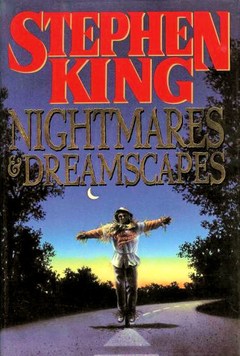
I’ve really been enjoying the process of digging through Stephen King’s work with this series.
I guess it must just be the personal nostalgia surround this book, but it’s my favorite of his short story collections. The fact that it varies so wildly in voice and theme keep it interesting in a way his other short collections lacked. Plus as a kid all the creepy teachers, revenge fantisies, and hellish creatures were way more interesting than some of his more cerebral work. “The Ten o’Clock People” and “Crouch End” had me shivering in fear under the covers for years, and I still think of that story when I see groups of smokers huddled outside a building.
It’s certainly interesting to get other’s prespectives of these stories, sometimes reading can isolate you in your own bubble.
The House On Maple Street was King’s go at one of Chris Van Allsburg’s The Mysteries of Harris Burdick prompts, which explains the YA feel. http://www.hmhbooks.com/features/harrisburdick/inspired_by_burdick.html
There was a TV miniseries based on these stories several years back. I want to say 2006. And I think it was shown on TNT.
The one episode I remember was called “Battleground” with William Hurt. Try to find it if you can. It’s good!
I’ve seen “Battleground,” “Rock ‘N Roll Heaven,” and “Umney’s Last Case” from the TNT series, and they weren’t half bad. But I haven’t seen the other ones. I actually really like The Night Flier, even the movie, and a lot of the stories in this collection I thought were pretty good. But you’re right that some of the old, bottom of the drawer stories could have been either taken out completely or reworked by the author. Some are just weird, such as “The Moving Finger,” and I like when no explanation is required or needed and you just go along with the story as it is just because. I agree that it may be his weakest short story collection up until that time, but there is a wonder that I like in short tales and his are no exception.
This article was a great way to pass the time….I just had to say it since I don’t think you used a variation of that phrase enough.
Dolan’s Cadillac might not be King’s favorite story, but it’s one of the few from this collection that has stuck in my memory over the years. I kind of remember reading the others, but only because I know I must have read them. I couldn’t remember which collection Dolan’s Cadillac was in (I’ve been expecting to see it in both of your previous reviews of King’s short stories) and the title of the story itself completely escaped me. Nonetheless I can’t forget the detailed and specific revenge it plotted. It’s definitely one of my favorites.
I read this when I was around 17 (almost 20 years ago) and what I remember thinking about some of these stories is completely different from your impressions, Grady.
I really enjoyed Dolan’s Cadillac, for instance. It was a tight, interesting story and the idea of Dolan stuck in his car really, truly scared me.
I hated Dedication. It was gross and felt pointless to me. Maybe it just went over my head (a lot of King’s stuff did that when I was in high school).
I absolutely loved Head Down. I played a lot of Little League baseball as a kid, so that aspect of it made sense to me. I think it was a story that I could actually understand, since it was about a subject I understood. But I remember being impressed that King could keep me interested in the team’s season.
Going through this readthrough (which I have really enjoyed, by the way) it’s struck me that part of the reason that I loved certain King books (like Needful Things or parts of this one, even) is that I didn’t know all of his favorite tropes yet. If you’ve only read a few of his books then you don’t know all of his tricks, so things are new and exciting. I think the secret to loving King is to take his stuff in small doses. A book or two a year at most. Otherwise, it’s too easy to see the commonalities between them. This is the approach I take to other authors I love that have huge catalogues of work to choose from (Terry Pratchett, for example).
There’s a movie version of “Dolan’s Cadillac”, too.
I really liked “The Ten O’Clock People”.